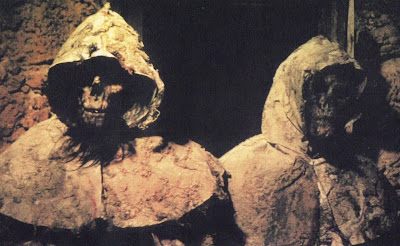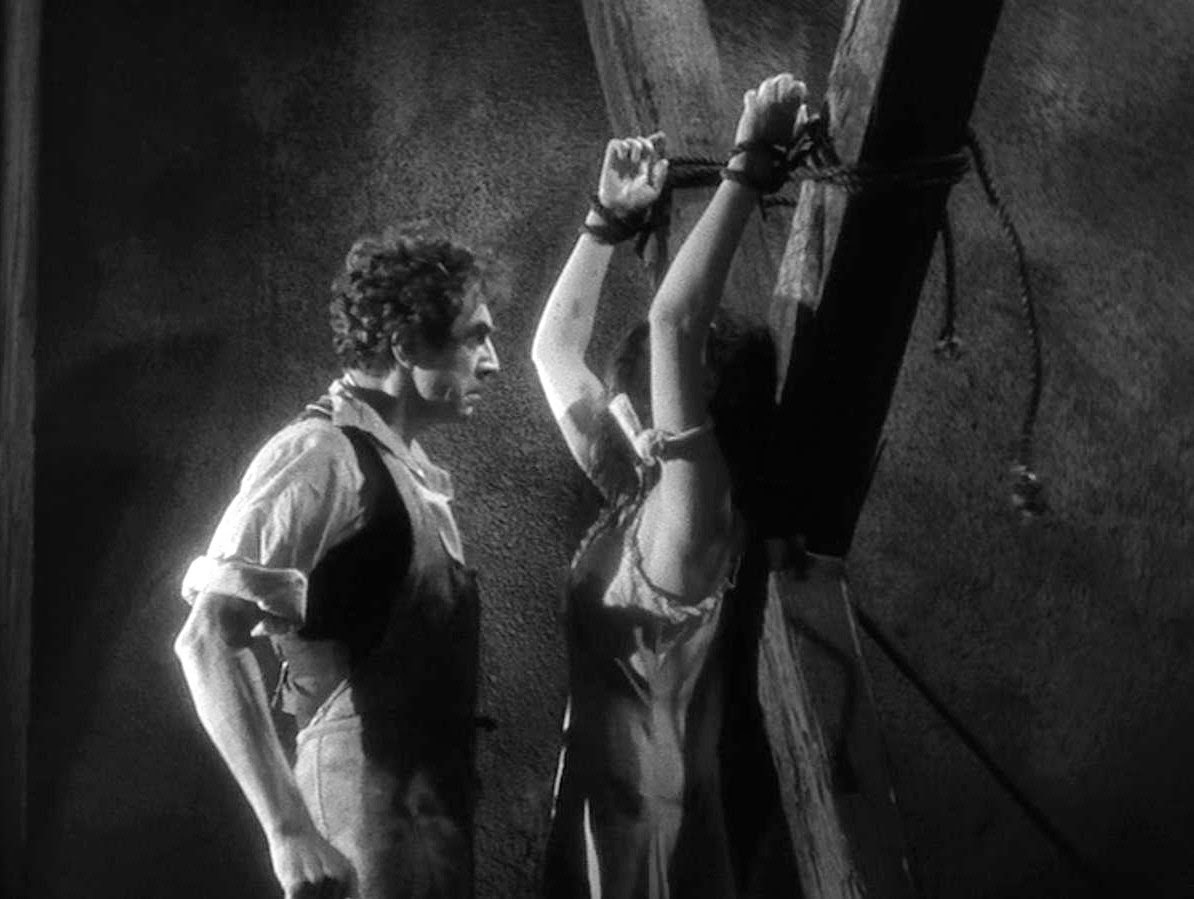October is coming up fast, so here's the next installment of this series. I've been trying to cast a wide net across the history of horror movies, but there are some periods when the genre was in serious remission (I'm looking at you, early to mid 1990s). I'm fascinated at how great horror movies cluster around certain times: the early 1930s, the 1970s, the 2000s. I'm tempted to pontificate on the sociology of these groupings, but I'll spare you that. In any event here's the next ten films for your perusal:
Tombs of the Blind Dead (1972, directed by Amando de Ossorio)
The spectral Knights Templar, the terrifying monsters in Tombs of the Blind Dead, are a triumph of image over text. Tombs of the Blind Dead is a mishmash of genre improvisations, some inspired by Night of the Living Dead, some inspired by the contemporary Euro horrors of its day, that don't necessarily fit together very well, but that doesn't really matter much. Tombs is a dream narrative, and the image of its undead horsemen galloping across the plains of Iberia strikes deep chords in the unconscious mind that reverberate through subsequent cinema (the Ringwraiths in The Lord of the Rings films are indebted to the Knights Templar). This is a film where mood and atmosphere are triumphant over internal logic. It has an instinct for the jugular, too, as its utterly nihilistic ending testifies.
Häxan (Witchcraft Through the Ages, 1922, directed by Benjamin Christensen)
Häxan is ostensibly a documentary about the history of witchcraft, approached from a contemporary (in 1922) psychological point of view. It spends some time debunking the rise of witchcraft in the middle ages as mass hysteria and hallucination, but nobody comes away from the film thinking that that's what the film is about, because it stages reconstructions of demonic hysteria with all the force of the silent cinema, which is considerable. This is an utterly gorgeous film, filled with rich textures and beautifully ugly faces. Häxan is a film that sets a standard for both special effects and make-up that's still impressive nearly a century later. So much of its imagery plumbs profound depths of surrealism that its impetus as documentary tends to get lost, but that's part of its charm. Though later films like The Devils, Mother Joan of the Angels, and the entire subgenre of nunsploitation films all show Häxan's influence, there's nothing else in cinema quite like it.
The Murders in the Rue Morgue (1932, directed by Robert Florey)
Even before its original release, The Murders in the Rue Morgue was thought to be too brutal by Universal Pictures. They cut it down to a slim 61 minutes from its original 80, in spite of the fact that the Production Code was not being enforced. It's easy to see why: this is a film that's laced with sadomasochism (as the above still demonstrates). The story? Well, it has as much to do with Poe as Roger Corman's Poe films three decades later. In Poe's place is some nonsense about a mad scientist abducting women and injecting them with the blood of apes, and in the grand scheme of things, it doesn't matter. This is also a film where the image trumps the text. This is one of Hollywood's most glorious dalliances with German Expressionism. Everything is created "on set" in this movie, creating one of the horror cinema's most indelible otherwheres in a Paris that never existed except in dreams, and it's lit and shot beautifully by the great Karl Freund. Director Robert Florey, not inclined to be stifled by the limitations of early talkies, finds creative ways to move the camera as if the silent cinema never ended. Bela Lugosi is ever-malevolent as the sinister Doctor Mirakle. The film was a failure in its day, thus dealing Lugosi a career setback from which he never really recovered, but the film itself is one the crown jewels of Universal's horror films, even if they've neglected it.
The Ruins (2008, directed by Carter Smith)
Survival horror at its most basic, in which a group of vacationing young people travel to an unmarked Mayan pyramid only to be trapped atop it by the locals. There's worse things than the locals, though, and soon they discover to their horror the why of their confinement. This is a brutal, visceral movie that finds novel ways to violate the bodies of its characters. It has a novel monster, too, and the most sinister flowers this side of Little Shop of Horrors.
The Whip and the Body (1964, directed by Mario Bava)
This examination of the sadomasochistic subtext of the Gothic, brought to the fore as text, finds Mario Bava in full bloom. The story itself, revolving around the forbidden kinky liason between a noblewoman and her cousin, is subversive enough, but Bava lavishes the story with ravishing technicolor imagery. This is the most beautiful of Bava's color films, which is saying something. It's criminal that it was neglected and mutilated for so long in the name of protecting community standards. This has never been thought of as first-rank Bava because of this neglect, but I'm telling you that it is. If you've already seen Black Sunday and Black Sabbath, then this should be your next stop.
Martin (1976, directed by George A. Romero)
Before he was entirely ensnared by the zombie films, George Romero produced this sober and disillusioned deconstruction of the vampire film, and through it, the Gothic horror movie in general. It's his bitterest film, which perhaps explains why it has lapsed into obscurity. Martin Cuda, Romero's vampire figure in this film is pathological rather than supernatural, though his superstitious uncle has different ideas. This is a film in which the mundane intrudes on fantasy and proves to be darker and more despairing. Romero cuts between fantasy ideations of vampirism and the actual reality of drinking blood from a pulsing vein in the early going, and the proceeds to examine the anomie and need for human connection that animates its monster. Its ending is brutal and bitterly ironic.
Dagon (2001, directed by Stuart Gordon)
Stuart Gordon's Lovecraft adaptations all preserve the spirit of the stories while often ignoring the text in favor of Gordon's own imp of the perverse, and that was never more true than in Dagon, a mash-up of the title story and "The Shadows Over Innsmouth." Parts of the film veer pretty far from Lovecraft, particularly its setting in a small Spanish fishing village. At times, it plays like what you would get if Visconti's La Terra Trema were reimagined by a lunatic. In spite of this, it's one of the few films that really "gets" Lovecraft on his own terms. The film isn't as broadly comic as Gordon's first two Lovecraft adaptations, but Gordon's own impulses aren't entirely absent. The film contains a wicked send-up of American fears about foreign hotel rooms and bathrooms that would never have occurred to Lovecraft. But for the most part, Lovecraft would have recognized this as his work, from the opening scenes beneath the sea to the surprisingly ambiguous climax.
Longer review here.

Deranged (1974, directed by Jeff Gillen and Alan Ormsby)
This recounting of the Ed Gein case has an eccentric story structure. While it follows the facts of the case in more or less chronological order, the movie is narrated by a fictional journalist played by Les Carlson, who shows up in-scene from time to time throughout the movie. This puts a vaguely post-modern sheen on the film, in spite of its grotty, drive-in exploitation look. The self-referential nature of the film also shows up in the film's occasional black humor. The filmmakers obviously have a great deal of affection for Ezra Cobb--the stand in for Gein played wonderfully well by Roberts Blossom--but it's as if they have to put a layer of irony between themselves and Gein, especially given the sheer ghastliness of what's on screen. Gein was famously a momma's boy of the worst sort, and this aspect of the story is occasionally played as a sick comedy. Oddly enough, the filmmakers choose not to play Gein's penchant for crossdressing for laughs, but that may have to do with the fact that in real life and in the movie, Gein dressed up in mother rather than as mother. There's a surprising duplication of imagery between Texas Chain Saw and Deranged. The central set piece in both films is a dinner party in which the guest of honor is the current victim, though Deranged puts an emphatic stamp of "no exit" on its version.
Longer review here.
Below (2002, directed by David Twohy)
Below, a ghost story set on a submarine during World War II, has an oblique approach to the supernatural, an ambiguity about its ghost, and a story structure built around a couple of devastating set-pieces. Twohy has a knack for set-pieces, actually and without suggesting that Twohy is the second coming of Jacques Tourneur, I'll set this film's set pieces against some of the best in the genre. The first of these is an extended exercise in submarine warfare that may be the best submarine battle ever put on film. The fact that the film is milking this type of warfare for a different sort of fear and dread than usual only adds spice to the proceedings. When the depth charges hit the water, they are terrifying in a way that no other film I can remember matches, and the following sequence where the ships on the surface are dragging the water with hooks is even more effective. The film's second set-piece, one that follows logically from the first, follows a trio of divers into the hull. This is the film's best sequence, one that wrings every ounce of suspense from its setting. A more frightening place would be hard to imagine, and nevermind the ghosts. The third set piece is of a different sort, when the arcing ships batteries set fire to a compartment that is flooded with oxygen. The way this sequence is edited is a brilliant example of the Val Lewton technique of letting the audience fill in the blanks, but it one-ups the audience's worst fears. It's one of the most horrifying sequences in recent film, and the worst of it happens offscreen, with nary a peep to brace the audience for what's to come. Hell, the supernatural elements are almost an afterthought. Regardless, this succeeds in that most basic of horror-movie functions: it's damned scary.
Longer review here.
Deathdream (1972, directed by Bob Clark)
A reworking of "The Monkey's Paw" for the Vietnam era, Deathdream (aka: Dead of Night) is an early iteration of the zombie movie as social satire. Its zombie is a "returned" veteran wished home by his family, unable to adjust to the homefront and possessed by violent impulses. This provided another newly returned Vietnam veteran, Tom Savini, with one of his first film gigs and his effects are gruesome and creative. There's a strong thread of humor to go along with its ghastliness. The film's best joke? "Why would a soldier want to kill anyone?"
That's it for today, kiddies. Come back again tomorrow, but beware. This stuff'll rot your brains. Heh, heh...

I'm trying out Patreon as a means of funding my blogs. They don't have a widget yet, so this link will just have to do. If you like my writing and art and if you'd like to support Krell Laboratories and Christianne's Art and Comics, please come on over and pledge. Thanks.


























No comments:
Post a Comment